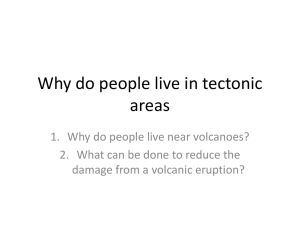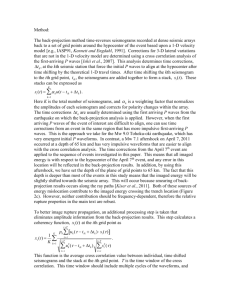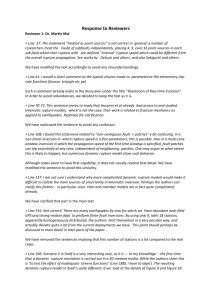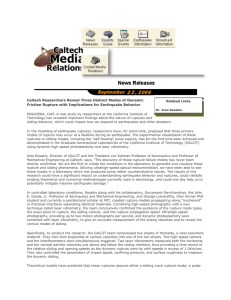Open questions in earthquake physics and the contribution of
advertisement
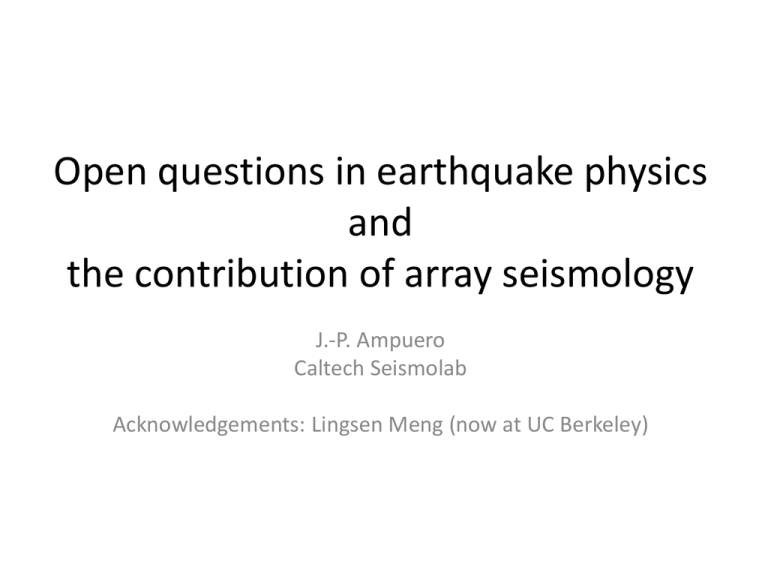
Open questions in earthquake physics and the contribution of array seismology J.-P. Ampuero Caltech Seismolab Acknowledgements: Lingsen Meng (now at UC Berkeley) Overview • Earthquake physics: how earthquakes start, propagate and stop? + broader impact • More specific open questions • Limitations of source inversion • Contribution of array seismology General goals of earthquake dynamics research • How earthquakes start, propagate and stop? • Relation between rupture patterns and mechanical properties of the fault zone at a variety of scales: friction law, state of stress, offfault inelastic deformation, geometrical roughness • Fundamental quest: bridge the gap between first principles and observations at laboratory and natural scales • Practical impact: physics-based earthquake hazard assessment, time-dependent hazard, earthquake predictability, situational awareness, earthquake early warning Some open questions in earthquake seismology • • • • • • • • • What controls rupture speed? What controls rise time? What controls the location of high and low frequency slip? How large is the spatial variability of these source parameters? How do frictional properties and stress vary along active faults? How deep can ruptures propagate? When and how far can rupture jump/branch to other fault segments? How is rupture affected by the subduction wedge, the fault geometry, the presence of a low velocity fault zone? Can slip nucleate repeatedly during a single earthquake? from Rippeger et al (2007) Gabriel et al (2012) Rupture complexity: multiple rupture fronts based on source inversion by Lee et al (2011) Slip rate Rupture front splitting Repeated front Gabriel et al (2011) Reverse front Nielsen et al (2010) Intrinsic limitations of source inversion • • • • • • Source inversion = infer the spacetime distribution of slip from seismological + geodetic + field + tsunami + remote sensing data Only seismological data constrains the time-dependency of the source Poor knowledge of the crust structure at small scales only low frequencies (<<1Hz) are exploited Resulting slip models are notoriously heterogeneous (spatial variability) However, the inverse problem is intrinsically ill-posed limited spatial resolution (>10km) Can we distinguish real source complexity from inversion artifacts? What can we trust? from Martin Mai and SIV project Earthquake source imaging by back-projection of teleseismic array data Introduced by Ishii, Shearer et al (2005) Principle: 1. Identify coherent wave arrivals across a dense tele-seismic array 2. Use their differential arrival times to infer source locations 3. Repeat as the earthquake unfolds, in order to track the rupture Seismic array Source region Seismic rays (Hutko, 2009) High-resolution is obtained by exploiting high-frequency waves (~1Hz) Earthquake source imaging by back-projection of teleseismic array data Introduced by Ishii, Shearer et al (2005) Principle: 1. Identify coherent wave arrivals across a dense tele-seismic array 2. Use their differential arrival times to infer source locations 3. Repeat as the earthquake unfolds, in order to track the rupture (Hutko, 2009) High-resolution is obtained by exploiting high-frequency waves (~1Hz) Earthquake source imaging by back-projection of teleseismic array data Advantages of back-projection compared to source inversion: • High frequency teleseismic data (1 Hz) • Less affected by uncertainties in velocity model • Minimal assumptions about fault geometry • No assumptions on rupture kinematics and size Challenges and how we addressed them: • Multiple sources MUSIC method • Non-stationary signals multitaper method • Swimming artifacts reference window method • Limited coherency (see later talks by C. Langston and L. Meng) Tohoku earthquake Details of the rupture process Sketch: position of the rupture front at regular times High-frequency radiation is deep A possible interpretation, : Deep brittle asperities surrounded by creep + Stress concentrations at the edge of past earthquakes Similar concept emerged from slow slip and tremor observations elsewhere Ito et al (2007) Ito et al (2007) Dynamic modeling Yingdi Luo, earthquake cycle simulations Percy Galvez 2012 M8.6 Indian Ocean earthquake India-Australia diffuse deformation zone, an emerging plate boundary DeMets et al, 2010 Largest strike-slip earthquake ever. Not really an intra-plate event. Europe Japan Time (s) As seen from Europe As seen from Japan ②-NE ④ ① ②-SW ③ B C A Rupture branching despite compressive dynamic stresses low pressuresensitivity of fault strength Theoretical expectations confirmed by dynamic rupture simulations Rupture branching despite compressive dynamic stresses low pressure-sensitivity of fault strength Perspectives • Contributions of array seismology: – Provides observational constraints on rupture history with minimal assumptions – Breaks the high-frequency (1Hz) barrier in source imaging – Reveals unexpected rupture patterns – Provides a fast estimate of rupture size and areas of high-frequency radiation for situational awareness (ShakeMap in poorly instrumented regions, or when local system fails) • Challenges: – Broadband integration of HF array imaging and LF source inversion – Optimal data fusion: how to merge information from multiple arrays? – Quantify and mitigate uncertainties on location, timing and amplitude of high-frequency sub-sources – Can we push to higher frequencies > 1Hz? Can we beat scattering? smaller magnitude earthquakes





